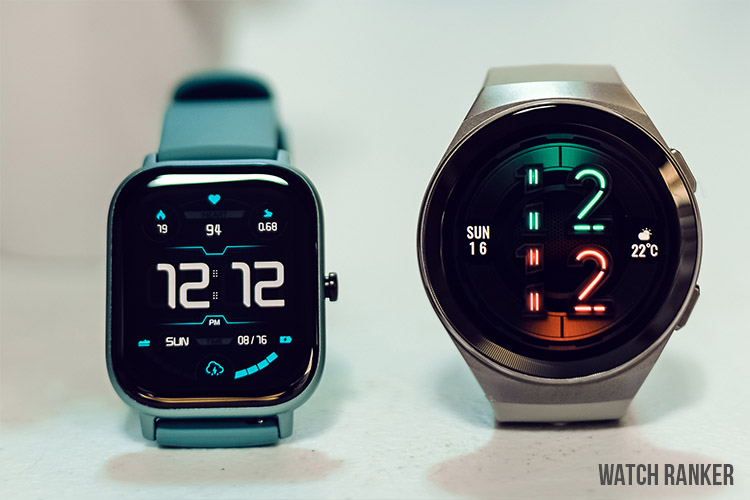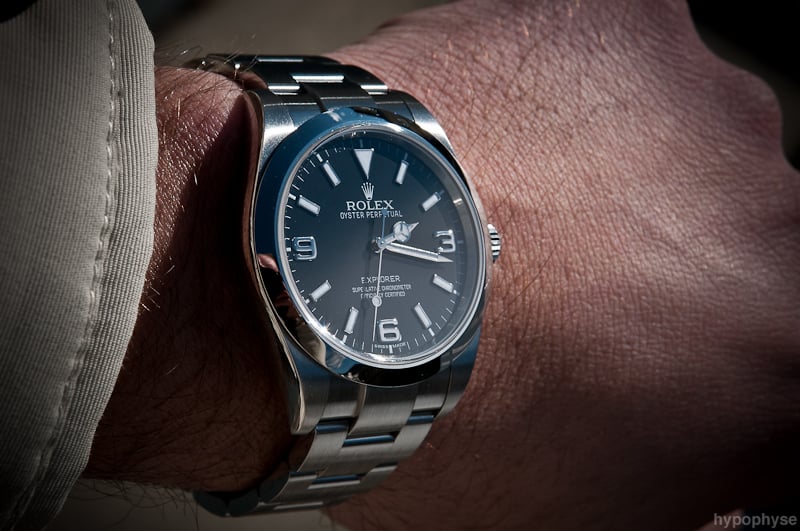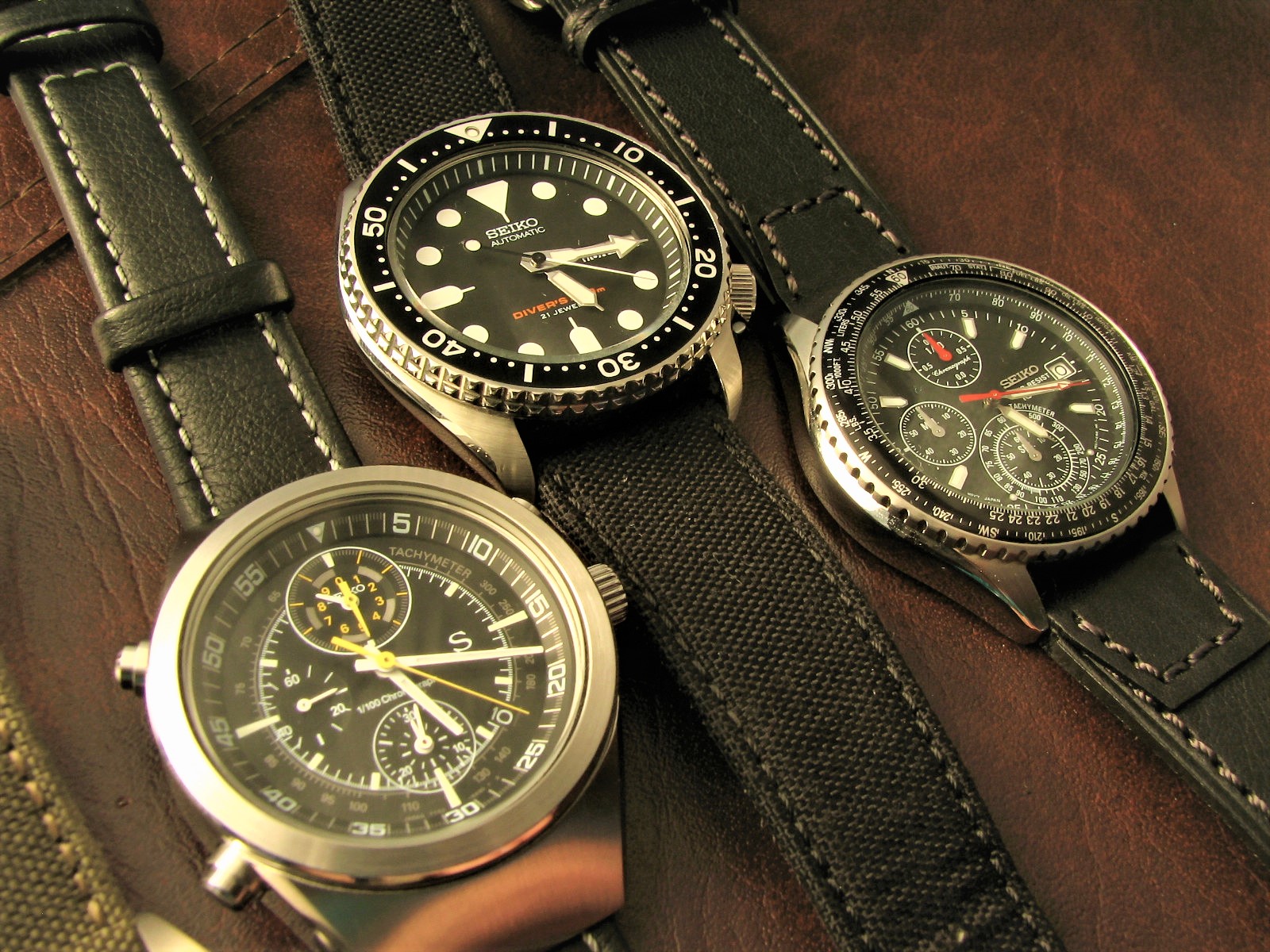Winner: Huawei Watch GT 2e
Both models are great options for anyone looking for a quality smartwatch in the midrange market. However, the GTS feels like a smartwatch that is made to be positioned solely in the midrange market. The Huawei Watch GT 2e, on the other hand, feels like a watch that can compete with much more expensive watches.

The midrange smartwatch segment is one of the most important price points. It serves as an affordable gateway to the world of smartwatches. These products also help determine whether or not customers would want to invest in a specific smartwatch ecosystem.
Today, we have two excellent choices in the midrange price point. We have the Huawei Watch GT 2e and the Amazfit GTS. While the two watches are designed for completely different brands, they have a very similar feature set and similar software experience. The GT 2e is designed for sports enthusiasts, while the Amazfit GTS is designed for more casual users.
Ultimately the better smartwatch is going to depend on your needs. So we compared the two watches in different areas such as build quality, software performance, etc. Join us as we walk you through the differences of the Amazfit GTS and Huawei GT 2e.
Also, don’t forget to check out our full review of the Huawei Watch GT 2e for a more in-depth look at the watch.
Table of Contents
Huawei Brand Overview
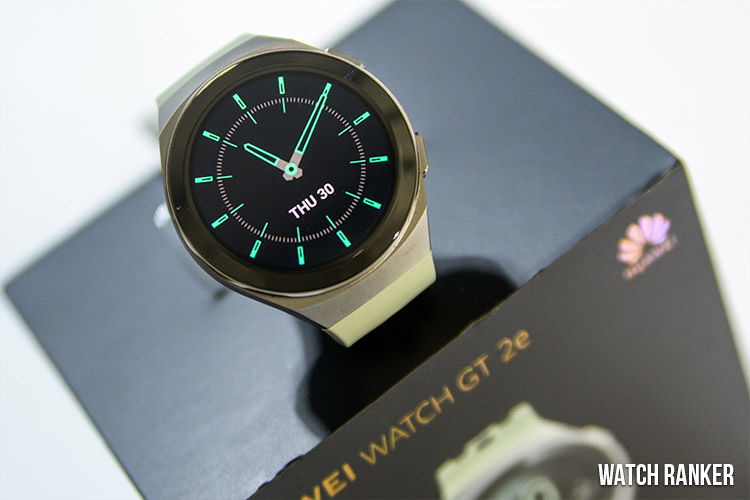
Huawei is no stranger to the smartwatch market. They have made successful smartwatches in the past, such as the original Huawei Watch and Huawei Watch GT. However, the success of their watches has largely been overshadowed by the success of their smartphones.
Their wearables have been mostly a side project in the past. However, in recent years, they have been consistently revamping their lineup and are proving to be a fierce competitor in the smartwatch market. This is evident with the successful release of the Watch GT Series.
Huawei has most notably moved away from Google’s Wear OS platform and has developed its proprietary operating system called the Huawei Light OS. Their current lineup is simple and is easy to follow. It consists of the flagship Watch GT 2, the midrange Watch GT 2e, and the original Watch GT (which may be discontinued in the future).
You can learn more about Huawei’s history and product lineup in our Huawei Brand Overview.
Amazfit Brand Overview
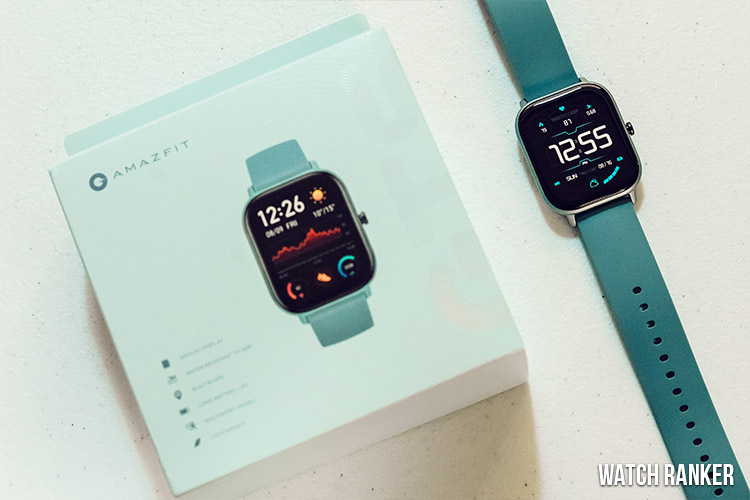
Compared to Huawei, Amazfit is a newcomer to the smartwatch industry. They are a US-based company that was only established in 2016. However, they have mostly been getting more attention due to the number of products that they produce each year.
Amazfit is currently the exclusive partner of Xiaomi. Together, they have become the second-largest wearable manufacturer. This is an impressive feat, given their relatively young age in the industry.
Their current lineup is more diverse and targets a wide range of audiences. They have budget offerings such as the Pace series as well as more high-end watches such as the Stratos Series. The Amazfit GTR and GTS, are, of course, their midrange and fashion-oriented offerings.
Specs
| Huawei Watch GT 2e (46mm) |
Amazfit GTS | |
| DIMENSIONS | 53 x 46.8 x 10.8 mm | 43.25×36.25×9.4mm |
| WEIGHT | 43.5g (without the strap) | 24.8g (without the strap) |
| WATCH CASE MATERIAL | Metal + Plastic | Aircraft-grade aluminum alloy, polymer material |
| WATCH STRAP | Black Fluoroelastomer Strap, Red & Black TPU Strap, Green & Black TPU Strap | Silicone strap |
| DISPLAY | 1.39 inch AMOLED 454 x 454 HD 326 PPI The AMOLED touchscreen supports slide and touch gestures. |
1.65 inch AMOLED 348 X 442 341 PPI |
| CONNECTIVITY | Bluetooth: BT5.1, BLE / BR / EDR | BT5.0 BLE |
| COMPATIBILITY | Android 4.4 or later & iOS 9.0 or later | Android 5.0 or iOS 10.0 and above |
| SENSORS | Accelerometer sensor Gyroscope sensor Geomagnetic sensor Optical heart rate sensor Ambient light sensor Barometer sensor Capacitive sensor |
BioTracker PPG Biological tracking optical sensor 6-axis acceleration sensor 3-axis geomagnetic sensor Air pressure sensor Ambient brightness sensor |
| BATTERY | 14 days for typical use. | Daily use mode:14 days |
| Basic watch mode:46 days | ||
| GPS continuous working:25 hrs | ||
| BATTERY | 455mAh | 220mAh |
| CONTROL | Touch+2 function keys | Touch+1 function key |
| WATER RESISTANCE | 5 ATM water-resistant | |
| 5ATM | 5-ATM rated water has a water resistance rating of 50 meters under ISO standard 22810:2010 Suitable for splashes, swimming, rain or snow, and snorkeling Not suitable for scuba diving, high-speed water sports, diving into water or hot water showers. |
|
| GPS | GPS + GLONASS | GPS + GLONASS |
| SPORTS MODE | 100 | 12 |
| NFC | Supported (limited in China Version) | |
| Mic and Speaker | Not supported | Not supported |
| Music Storage | Supported | Not supported |
| SpO2 | Supported | Not supported |
| Heartrate | Normal + underwater | Normal |
| Chip | Kirin A1 | Unspecified |
| RAM+ROM | 16MB/4GB | Unspecified |
Packaging and Unboxing Experience
Winner: Huawei Watch GT 2e
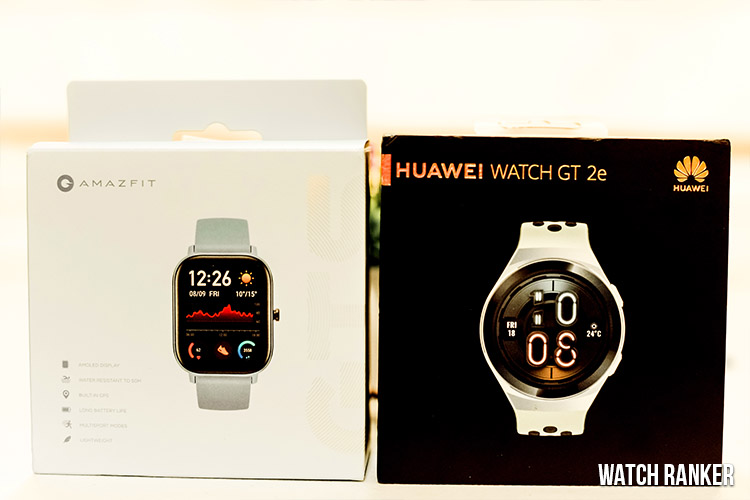
We don’t usually compare the unboxing experience of smartwatches since they do not have a direct impact on the performance of the product. However, there is a pretty big disparity between these two models that we can’t help but mention.
The GT 2e has a premium unboxing experience that is similar to the higher-end Huawei Watch GT 2. Everything from the shape and artwork of the box to the presentation gives you a genuine feeling of excitement. For a moment, you might even forget that the GT 2e is just a midrange smartwatch.
The GTS, on the other hand, is the exact opposite. It’s been quite obvious that Amazfit has skimped out on the unboxing experience. You just get a cardboard box with a design that isn’t too inspiring. Aside from its color matching design, there isn’t a lot going on here.
The presentation is rather straightforward, which is okay given its price point. But overall, the packaging isn’t anything special, and I imagine a lot of people won’t keep it.
The unboxing experience does not directly impact the performance of the watch. However, it is the first impression that customers get when first handling each product. It usually serves a good measurement of how each company cares about their product. But now that’s out of the way, let us proceed to more important aspects of the watch.
Design and Build Quality
Overall Winner: Huawei GT Watch 2e
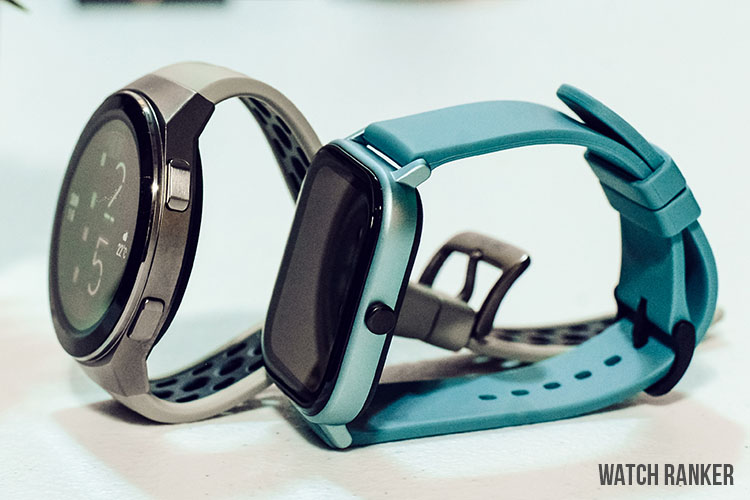
Design Language
Winner: Tie
The Huawei Watch GT 2e and Amazfit GTS are two completely different looking watches when it comes to their physical design. The GT 2e has a more traditional rounded display while the GTS has a square display.
The Huawei Watch GT 2e closely resembles its higher-end counterpart, the Watch GT 2. The GTS, on the other hand, looks significantly different from the more expensive Amazfit GTR.
Both smartwatches come with a variety of different colors and support different watch faces. Both watches are also designed to fit the younger audience compared to their classy and formal looking counterparts.
Overall, both watches are well designed. It will come down to which shape you prefer.
Weight and Dimensions
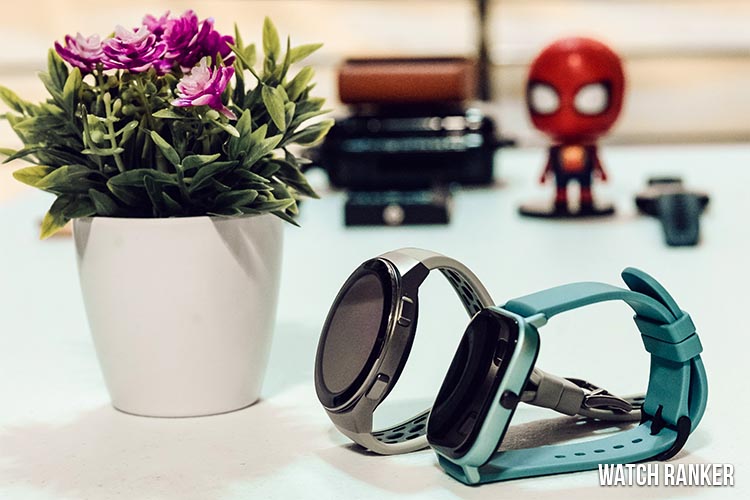
Winner: Tie
The Amazfit GTS is the smaller smartwatch and has the following dimensions: 43.25 x 36.25 x 9.4mm. The Huawei Watch GT 2e, on the other hand, is larger and has the following dimensions: 53 x 46.8 x 10.8 mm.
The Amazfit GTS is the lighter smartwatch and is almost half the weight of the Huawei Watch GT 2e. It only weights 24.8g. The Huawei Watch GT 2e, on the other hand, is inevitably the heavier watch due to its larger size. It weighs at 43.5g.
The GT 2e is by no means an uncomfortable smartwatch, even with smaller wrists. However, I have to admit that the smaller form factor and lightweight nature of GTS feel a lot better on my wrist. I sometimes forget that I am wearing a smartwatch while using the Amazfit GTS.
On the flip side, the Huawei Watch GT 2e feels more premium thanks to its heft. But in the end, both feel like high-quality watches. Once again, it all comes down to personal preference.
Display
Winner: Tie
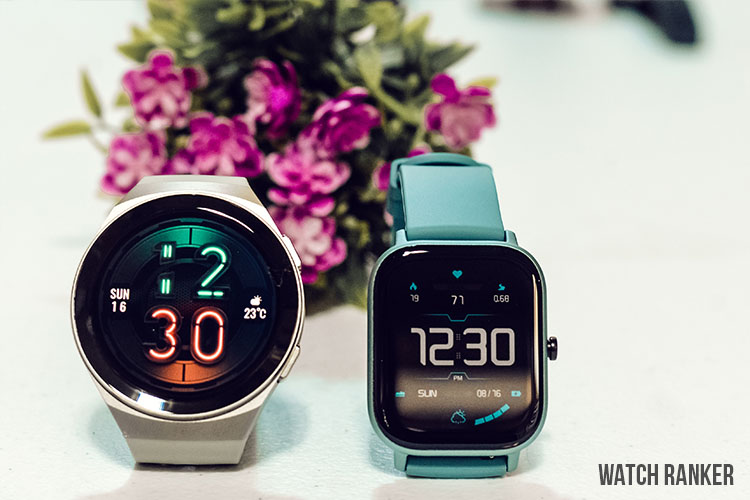
The Huawei Watch GT 2e has a 1.39-inch display, which is a bit smaller compared to the Amazfit GTS’ 1.65-inch display. However, due to its larger size, the screen appears to be larger. Unfortunately, the bezels are also more pronounced compared to the GTS’ hidden bezels.
Both smartwatches feature a bright and vibrant OLED display. They are both sharp, and the text was easy to read regardless of the lighting condition.
The Huawei Watch GT 2e had a higher resolution (454 x 454 pixels with a pixel density of 441 PPI) compared to the Amazfit GTS (348 x 442 with a pixel density of 341 PPI). However, the lower resolution of the Amazfit GTS did not bother me too much since the watch was smaller.
Both displays were equally responsive to touch inputs. I initially thought the smaller size of the GTS would make it harder to press, but this was never the case.
Overall, both displays were excellent. The Huawei Watch GT 2e’s display seemed better on paper, but in practice, the difference wasn’t that big. The real deciding factor will come down to how well the software implementation is as well as how good the watch face designs are. We will be talking more about that later in its dedicated section.
Buttons
Winner: Huawei Watch GT 2e
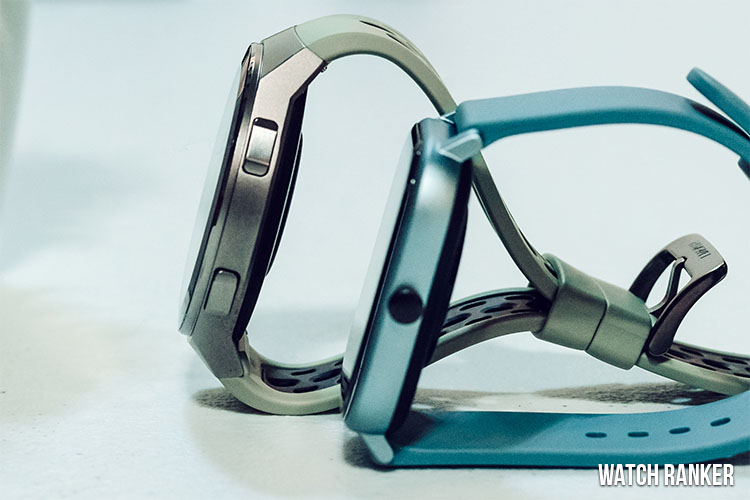
The Huawei Watch GT 2e features two buttons. The Amazfit GTS, on the other hand, only features one button. However, the GTS’ single button can do the same functions as the GT 2e’s second button by long-pressing it.
By default, these buttons access the workout modes. Both buttons can also be programmed to quickly access other features such as the weather, notifications, etc.
This could have been a tie, but Amazfit greatly wasted the single press functionality of the GTS. This button is only utilized for turning the screen on and off. I find this to be useless since putting down your wrist would shut off the screen anyway.
I would have preferred if Amazfit gave us the option to bind the single press to something more useful. This would greatly help in navigating through the menu (you’ll soon find out why in its dedicated section).
In terms of the shape of the buttons, the GTS has a round button that sticks outside the body. The GT 2e, on the other hand, has flat buttons that sit more flush with the body. It is designed this way to avoid bumping into the wrist during workouts. However, it is worth noting that the GTS’ button will not bump into your wrist during workouts due to the small size of the watch.
Both buttons are tactile and require a good amount of force to press. They both feel great, and I did miss any presses with them.
Strap
Winner: Tie
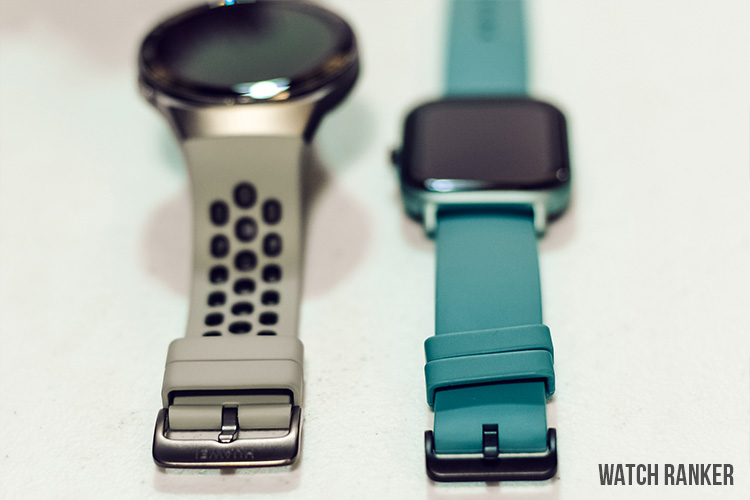
The GTS and GT 2e have completely different strap designs. The GT 2e has a more sporty look with holes for sweat ventilation. The GTS, on the other hand, looks more like a standard strap.
I initially thought the GTS had a lower quality strap. It is softer and has a more plasticky feel compared to the rubbery texture of the GT 2e. However, I didn’t find it to matter that much once they were on my wrist. Both felt great, and I could comfortably use them for the whole day without taking them off.
One gripe that I have with the GT 2e’s sporty design is that you can’t lay them flat. I usually use the GT 2’s AOD (Always On Display) functionality while I’m not wearing them. This way, I could quickly check on the time while the watch is on my desk while I’m working.
I cannot do that with the GT 2e since it sits at an awkward angle when I attempt to lay them flat (as seen on the pictures). The GTS does not have this problem since it has a regular smartwatch design.
Both have their pros and cons, and there is no definite winner. Both are high-quality straps that I did not have any issues with.
Features
Winner: Huawei Watch GT 2e
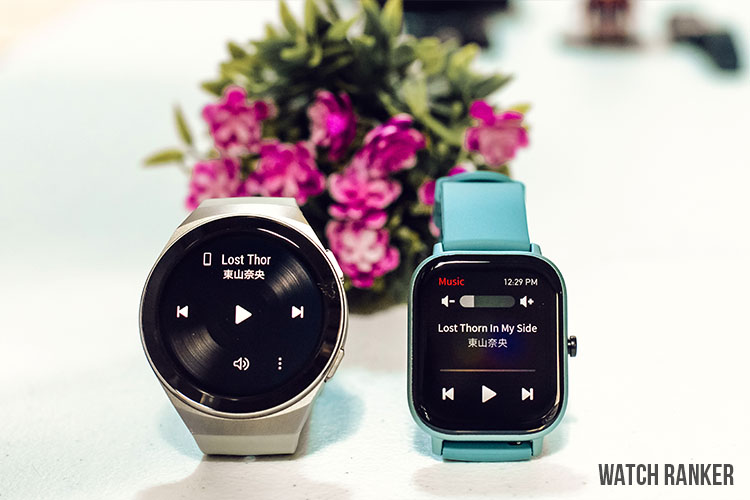
Both smartwatches cover the basic features that are typically found in this price range. But in almost all areas, the Huawei Watch GT 2e has the upper hand.
The GT 2e and Amazfit GTS offer a solid Bluetooth connection. There is a slight difference with the Bluetooth version that is supported by these smartwatches. The Watch GT 2e supports the newer Bluetooth 5.1 while the GTS only supports Bluetooth 5.0. The performance between these two is similar, and other factors such as the smartphone app make a bigger difference.
It is these next couple of features where Huawei truly starts pulling ahead. The Huawei Watch GT 2e can store music as well as give smartphone playback controls. The GTS, on the other hand, only offers smartphone playback controls.
The GTS, however, did not give a satisfactory experience due to the noticeable latency. The GT 2e was more usable thanks to the instantaneous and generally more reliable response.
The Watch GT 2e can also control your smartphone’s camera, which can be useful for doing certain shots such as group selfies. This was added via a software update, so it is unclear if the GTS will have similar functionality in the future.
The Watch GT 2e can also connect to Bluetooth earbuds such as the Huawei FreeBuds 3. This gives the GT 2e more flexibility since you can use your smartwatch as a music player during workouts or in situations where you do not want to get distracted by your smartphone. The GTS has no such functionality since it cannot store music.
Health Tracker
Winner: Huawei Watch GT 2e
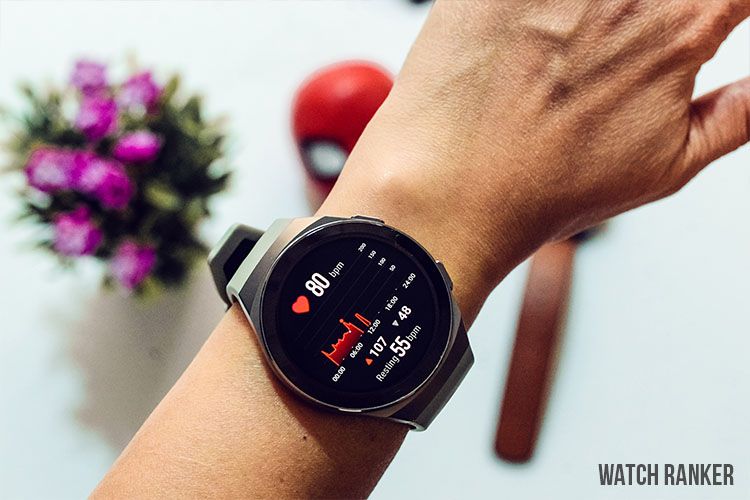
Both smartwatches nail the basic health monitoring features that any smartwatch should have. Both have a heart rate sensor, sleep tracker, step tracker, and various workout modes.
The GTS and GT 2e both support 24/7 heart rate monitoring. It is, however, worth noting that the GTS’ heart rate sensor was not always accurate and sometimes came up with unrealistic results. This is evident when the heart rate monitoring kept on showing results even if you are not wearing it.
Both smartwatches offer sleep tracking. However, their approach is quite different. The GT 2e allows you to see your sleep data on the watch. The application then gives you a more in-depth look and a breakdown between various data such as deep sleep and light sleep. The Huawei Health App gives you further options for analyzing your data through the Huawei TrueSleep feature.
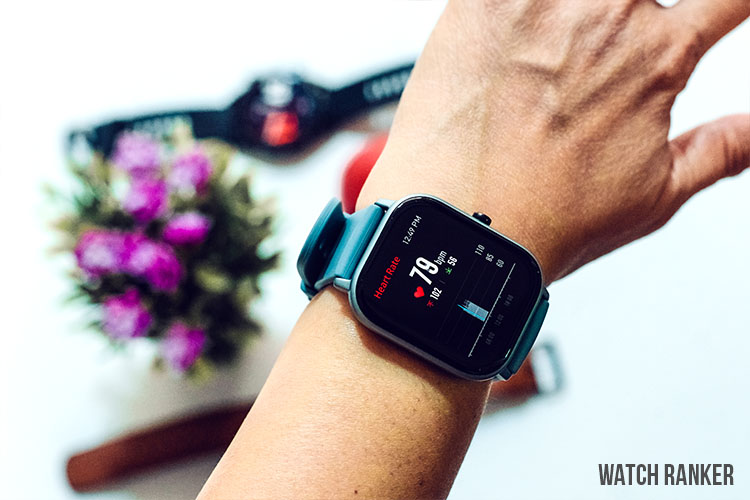
The GTS, on the other hand, does not have any menu for the sleep tracking functionality. Instead, you have to access the Amazfit application to see all of your sleep data. This can be annoying, especially if you are half asleep in the morning and are trying to check if you had enough sleep.
Lastly, the GT 2e offers automatic stress monitoring. However, during our testing period, I found the results to be inaccurate. The results were showing to be normal, even when I was extremely stressed. It’s a nice feature to have, but GTS users shouldn’t be bothered by its exclusion.
Fitness Tracker
Winner: Huawei GT 2e
![]()
Both smartwatches perform well in terms of fitness tracking. However, when it comes to the number of workout modes, the GT 2e obliterates the Amazfit GTS.
The Amazfit GTS covers all of the basics, such as Outdoor Running, Walking, Outdoor Cycling, Treadmill, Indoor Cycling, Open Water Swimming, Pool Swimming, Elliptical Trainer, Climbing, Trail Running, Skiing, and Freestyle.
The Huawei GT 2e, on the other hand, features 100 workout modes, which include basic workouts, sport-oriented workouts, and custom workouts. The GT 2e is marketed for sports enthusiasts, and it does not disappoint.
It is, however, worth noting that both smartwatches are not perfect. They both make mistakes, especially when counting steps. But that is a problem that is shared by most smartwatches. Overall, both watches perform great. But if you are an active user, you will be getting more value with the GT 2e.
Battery Life
Winner: Tie
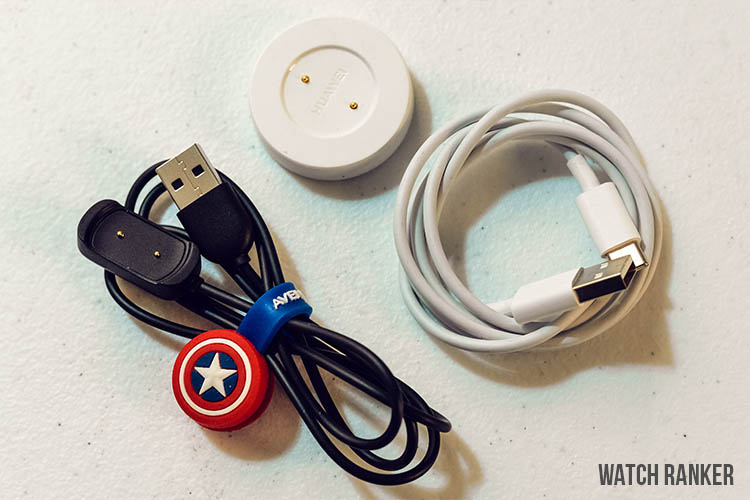
Both smartwatches have excellent battery life. They can both last up to two weeks of regular use. Of course, features like Always On Display and GPS will drain their batteries faster. But you will still be enjoying both of them for least one week before needing a recharge.
The Huawei Watch GT 2e has a 455 mAH battery, while the Amazfit GTS only has a 220 mAH battery. The GT 2e’s Kirin A1 processor makes sure that battery consumption is kept to a minimum. The Amazfit GTS is surprisingly able to keep up despite its smaller battery. Overall, both smartwatches are very efficient.
Both smartwatches offer proprietary magnetic chargers. However, I find Huawei’s implementation to be better. The cable on the magnetic charger is removable and connects via USB-Type C.
This means that you only need to carry the small magnetic charger and use the Type-C cable found on your smartphone’s charger. The GTS’ magnetic charger does not feature a removable design, meaning you have to carry the whole thing with you.
But then again, this shouldn’t be too much of a deal-breaker since you probably won’t need to charge your smartwatch often due to their superb battery life.
Watch Software Performance
Overall Winner: Huawei Watch GT 2e
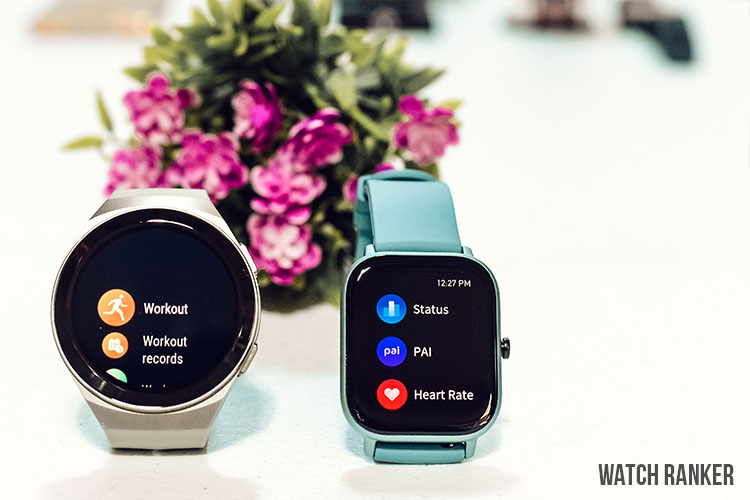
Icon Aesthetics
Winner: Tie
Both smartwatches have a similar menu layout. However, what sets them apart is the aesthetics of the icons. It is apparent that the Amazfit GTS’ aesthetic choices are influenced by the design elements found on Xiaomi’s smartphones. It isn’t as exaggerated as Xiaomi’s Android skins, but it is apparent that the GTS’ software experience is closely related to Chinese smartphones.
The Huawei GT 2e, on the other hand, has a cleaner approach that is not too reminiscent of Huawei’s EMUI Android skin. There are a few elements here and there, such as the quick access notifications, but overall, the clean design helps make the GT 2e fit in regardless of what smartphone you are using.
But overall, this comes down to personal preference. There is nothing wrong with either design, and both are usable. We will be giving this one a draw.
User Interface
Winner: Huawei Watch GT 2e
Both smartwatches have a similar user interface. The main screen has the watch face where you can scroll left and right to quickly access the fitness-related applications.
The GTS only has two additional screens that show the heart rate and daily health stats. The GT 2e, on the other hand, shows more information such as heart rate, stress, weather, media playback, and daily stats.
I personally think this is a lot better than the implementation of the Amazfit GTS, where you have to dig through the menu to access the weather app and the music playback controls.
But the Amazfit GTS executes the daily stats better. You can tap the screen to get more in-depth information about your daily stats. You can’t do that with the Huawei GT 2e.
You cannot modify the menus on both watches. This is a shame for the GT 2e since I would have preferred to have the media playback come up first and put the less used apps on the last.
Both smartwatches encountered frame drops but were not enough to detract from the overall experience. Overall, both watches had an excellent and well thought out user interface. But despite their similarities, the Huawei GT 2e has the more efficient UI.
Watch Faces
Winner: Huawei Watch GT 2e
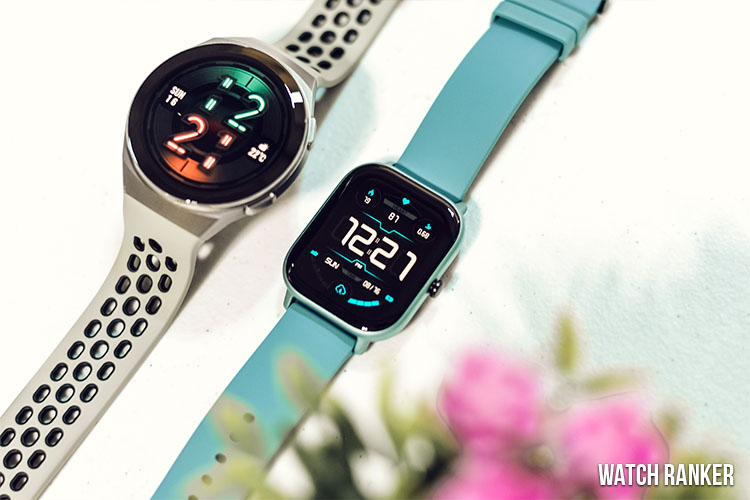
This is the area where I am not fully convinced by the Amazfit GTS. The stock watch faces did something special. You could modify the elements that you wanted to see, such as the date, the temperature, etc. This was very interesting since you couldn’t do anything similar to the GT 2e.
But sadly, this customization is only available for the two stock watch faces. The GTS starts falling behind the GT 2e once you access the third-party watch faces.
The Amazfit GTS has some great looking watch face designs. However, the majority of the watch faces are repetitive and are uninspiring. Most of the designs seemed like they belonged in a smart band rather than a smartwatch.

That’s not to say that all of the GT 2e’s watch faces are great. There are some odd choices here and there. But the majority of its downloadable offerings are better than Amazfit’s offerings. Even the GT 2e’s default watch face that features a light-up animation is a lot better than most of the GTS’ offerings.
Another problem that I have wit the GTS is that it can only store one downloadable watch face. This would have been okay if the syncing process was fast. However, the waiting times are painful. This entire process makes discouraging, especially if you wish to cycle through different watch faces.
The GT 2e, on the other hand, has a much faster-syncing process. And also, you can store more than ten watch faces and switch between without the watch.
Both smartwatches are, unfortunately, not officially compatible with third-party watch faces.
Notifications
Winner: Huawei GT 2e
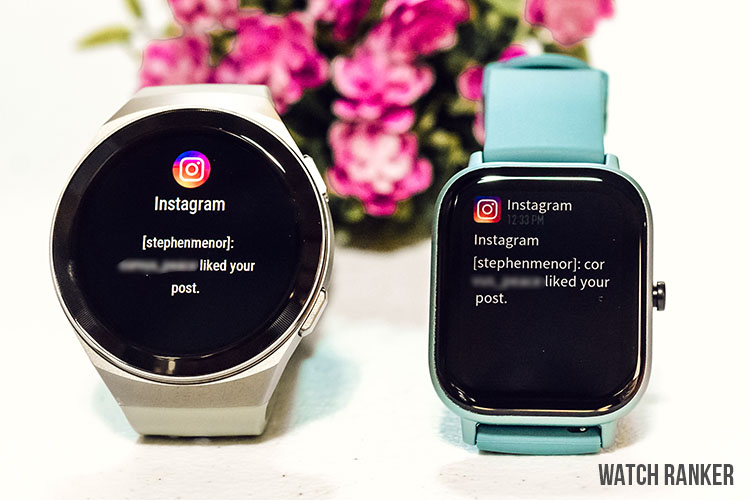
I am not a big fan of how notifications are handled by the Amazfit GTS. Like the Huawei GT 2e, your notifications pop up as soon as you receive them. You cannot interact with these notifications on both models.
However, if you miss your notifications on the GTS, then you will have to navigate to the notifications tab (which is buried under the main menu). This takes significantly longer compared to the Huawei Watch GT 2e, where you simply have to swipe up to access all your notifications.
There are several ways to get around this. You can change the order of the GTS’ menu via the smartphone app, or you can reprogram the long-press functionality to access the notifications. However, I still think it would have been easier, faster, and more natural to have a smartphone-like gesture instead.
Another gripe I have with the notifications is that you do not have a quick way of clearing all your notifications. You have to delete them one by one by swiping and pressing the delete prompt. And to make matters worse, the delete prompt does not always work, which can be frustrating if you have lots of notifications.
And to add to my list of complaints, notifications are sometimes not automatically cleared even if you already read them. This means that if you do not manually clear your notifications, you will eventually stop receiving them.
I also do not like how notifications are presented on the Amazfit GTS. Long texts are broken into two lines. This can be confusing, especially when reading usernames on your social media alerts. The GT 2e does a better job and utilizes the larger space better.
Overall, the notifications work on both models. However, Huawei’s implementation is infinitely better.
Overall Software Performance Winner: Huawei Watch GT 2e
The Amazfit GTS was initially the more interesting smartwatch for me. Its square display was expected to give off a unique experience. But in the end, it falls flat compared to the Huawei GT 2e.
Smartphone App
Winner: Huawei Watch GT 2e
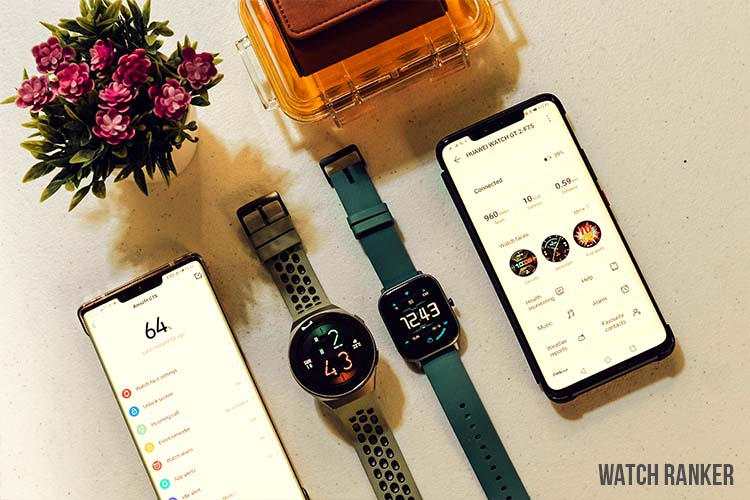
Unfortunately, Amazfit’s smartphone application is just as cluttered as the watch’s user interface. There are a lot of settings that you can modify on the smartphone app. However, I think it would have been better to have these options on the watch instead. Huawei’s implementation may not be the best, but at least it is far cleaner and easier to understand compared to Amazfit’s app.
Setting up the Amazift app is also not a great experience. It offers you the option to log in with your social media accounts. But this option ironically doesn’t work. Tapping on the various social media icons results in an error, regardless of which device I used.
This then leads us to the incredibly tedious account creation process. Instead of being a quick one minute process, the app continues to ask lots of information even if they are not related or directly usable by the smartwatch.
But the biggest issue that I have with the Amazfit smartphone app is that it constantly needs to sync with the smartwatch. Every time you open the app, it takes a few seconds to update various data such as sleep tracking and steps. Again, this is incredibly annoying when you are half asleep in the morning, and you just want to have a quick look at your sleep stats.
Again, both applications are not perfect, but Huawei’s app is the clear winner here. Amazfit needs to rethink their approach to its smartphone app if they want to be competitive in this price range.
Both applications can be acquired via Google Play Store (Huawei Health, Amazfit) for Android users and Apple Play Store for iOS users (Huawei Health, Amazfit).
Comparison Winner
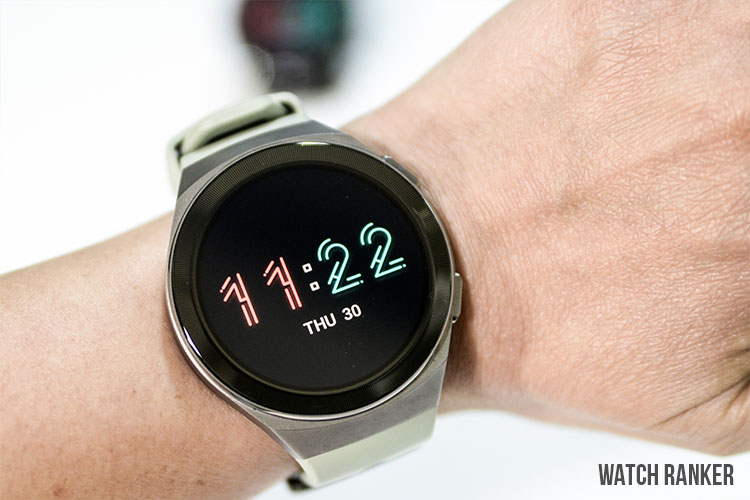
The GTS is by no means a terrible watch. It has the build quality and the features that you would expect on a smartwatch at this price point. And when it comes to smartwatches with square displays, the GTS is hard to beat.
The problem is that the GT 2e, a similarly priced smartwatch, executes almost everything better. It almost feels like Amazfit was trying to restrict the GTS’s performance to fit its price. Huawei, on the other hand, did not let the price hinder the GT 2e’s potential.
If you want a lightweight smartwatch with a square display, then the Amazfit GTS is one of the best options. However, if you want a smartwatch that provides better value, then we highly suggest that you grab the Huawei Watch GT 2e instead.

